www.ijtsrd.com e-ISSN: 2456 – 6470
Physical Vapour Deposition Method Based Microstructure Analysis of TiN Coated Surfaces in Aluminum Alloy 2024 Grade
C. Sangeevi1, A. Gopinath2, M. M. Tanush2
1Assistant Professor, 2UG Student, 1,2Mechanical Department, Sri Shakthi Institute of Engineering & Technology, Coimbatore, Tamil Nadu, India
ABSTRACT
TheAluminiumAlloy2024gradetendstocorrodethesurfaceofthe material, because it having copper content, it will undergo severe corrosion. Normallythesetypes ofAluminium grade are applied in the building of the body of the aircraft. The main drawback of this material is after the painting, it has to be frequently painted to decreasethecorrosion,forthoseaerospaceindustrieshavetospend moreamounts forthepainting. In this work, weconcentrated to get the better strength of Aluminium alloy 2024 grade by reducing the corrosion.ThefaceoftheAA2024islayeredwithTitaniumNitride (TiN) at ∼1.465µm thickness. This coating is prepared bythe PVD method, and after the coating process, the specimen is tested using theX-raySpectroscopyandSEManalysisforsurfacefinishandthe hardness test usingtheMicro hardness test.
KEYWORDS: Titanium Nitride (TiN), Aluminium Alloy 2024, Physical Vapour Deposition (PVD), Scanning Electron Microscope (SEM)
How to cite this paper: C. Sangeevi | A. Gopinath | M. M. Tanush "Physical Vapour Deposition Method Based Microstructure Analysis of TiN Coated Surfaces in Aluminum Alloy 2024 Grade" Published in International Journal of Trend in Scientific Research and Development (ijtsrd), ISSN: 2456-6470, Volume-6 | Issue-7, December 2022, pp.837-841, URL: www.ijtsrd.com/papers/ijtsrd52415.pdf
Copyright © 2022 by author (s) and International Journal of Trend in Scientific Research and Development Journal. This is an Open Access article distributed under the terms of the Creative Commons Attribution License (CC BY 4.0) (http://creativecommons.org/licenses/by/4.0)
I. INTRODUCTION
IntheAerospaceindustry,lightweightmaterialshave a major impact on the construction of Aeroplanes; these materials have the properties of more hardness and also a reduction in corrosion properties like Aluminium Alloy 2021 grade materials. These materials having a copper content, and this leads to severe corrosion, while it contacts with oxygen and water. For that, the majority of the Aeroplanes companies paints the materials to withstand the strengthandhardnessofthematerialstoincreasethe lifetimeoftheprintquality. Thisleadstoanincrease in the maintenance cost and also it takes frequent maintenancetokeepthesurfaceofthematerials.The commonlyusedAluminiumalloyhastheattributeof notbeingabletotoleratehigh-temperatureresistance while also having a low wear resistance. Aluminium alloy2024isavailableinboththeformsofplatesand in the forms of the sheet; the plates are used in the application of the fuselage structures, whereas the sheets areusedintheforms offuselageskins. In this studyweuseTitaniumNitride(TiN)asacoatingthe
surfaces of the Aluminium Alloy 2024, the TiN will bethehardmaterialsinthemetalfamilyanditapplied forthecoatings withthelessthan5µm.
Most researchers are focused on plasma nitriding a Titanium coating onto the AA2024 to boost its wear resistance.Byemployingmagnetronsputtering,nanosized titanium particles are coated on the surface of theAluminiumalloy2024grade,andthenthesameis plasmanitrateforeighthoursat300Cintervalstarting from4000Cto4900Candinagashavingamixtureof 40%&60% of N2 and H2. As compared to uncoated material,thewearrateisreducedby56percentafter thistreatment [1]. SomeofthemareusingthePlasmaenhancedchemicalvapourdepositionmethodonAA 2024. In this method they using the two different gasses at the ratio of 1:1, i.e. 50% oxygen and 50% hexamethyldisiloxane, plasma is ignited using the radiofrequencyat13.56MHz.Thepowerwasvarying from 10 W to 80W in the 6 different sets of experiments. Salt spray method & electrochemical
impedance spectroscopy will be used to assess corrosionresistance[2]. Basedontheseveralresearcher methodologies handling the AA 2024 with TiN, we adoptedthesurfacecoatingusingthePhysicalVapour DepositionMethod(PVDM).
II. Materials and Their Composition
For this study, we use the main materials as the Aluminium Alloy 2024 Grade and the Titanium Nitride Powder. The detailed properties of the AluminiumAlloy2024gradeareshowninTable1, and Table.2 describes the detailed properties of the Titanium Nitride.
Table.1
Property of Aluminium Alloy 2024 (AA 2024)
Physical Properties Properties
AA 2024
Density 2.78 g/cc
Mechanical Properties
Tensile Strength 483 MPa Yield Strength 345 MPa Modulus of Elasticity 73.1 GPa Thermal Properties Coefficient of Thermal Expansion 23.2 µm/m-°C Thermal Conductivity 121 W/m-K
Chemical Composition
Silicon 0.5% Iron 0.5% Copper 3.8% - 4.9% Manganese 0.5% - 0.6% Magnesium 1.2% - 1.8% Chromium 0.1% Zinc 0.25% Titanium 0.15%
Table.2 Properties of Titanium Nitride Physical Properties Properties TiN Density 5.21 g/cm3
Mechanical Properties TensileStrength 240 MPa Modulus ofElasticity 251 GPa ShearModulus 15.6 GPa
Thermal Properties Coefficient ofThermal Expansion 9.35×10 6 K−1 Thermal Conductivity 29 W/m-K Meltingpoint 2947 °C Chemical Composition Titanium 77.5% Nitrogen 22.6%
III. Preparation of the Substrate Material
For this study, we use the basic material as AA2024 gradeintheformofasquareplatehavingathickness of 4mm. After the primary cleaning process carried
on the plate, the plate will be cut for the required dimensions. For that the AA2024 grade is cut in the dimensions of 20 x 20 cm using the Wire cut EDM, specificationandthepictureoftheEDMismentioned in Table.3 and Fig.1.
Fig.1 Wire-Cut EDM
Fig.2 Surface Grinding Machine
Table.3. Specification of Wire cut EDM Parameters Range
MaximumCuttingspeed 160mm²/min Surface Finish 0.8 µ Taper ±30°/ 50 MME Tablesize 445 X 655 mm
Afterthecuttingprocess,thesurfaceistobegrinding for 0.25 mm using the surface grinding machine, specification and the picture of the surface grinding machine is mentioned in Table.4 and Fig.2.The prepared material is shown in Fig.3.
Table.4. Specification of Surface Grinding Machine Parameters Range
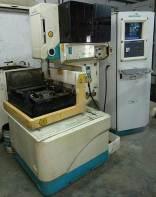
Maximum GrindingDia. 150 mm Max. Grinding Length 450 mm SpindleSpeed 2800 RPM MotorPower 1 HP
Fig.3 shows that the prepared substrate of the Aluminium alloy 2024 after all the preparation. Simultaneously, Titanium Nitrides (TiN) is used for this study is in the form of a Powder state, for that Titanium Nitrides (TiN) is to be filtered using Nano filter, from which the above 0.70 µm are filtered as shown in Fig. 4

Fig.
Fig. 3 Prepared Substrate Material
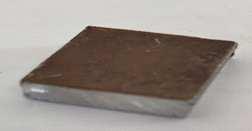
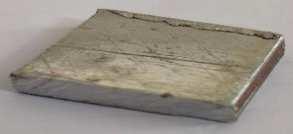
Fig.
7 Procedure for the TiN coating in
the AA 2024
V. Testing Process
4
Titanium Nitride Powder at 0.70 µm
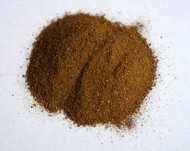
IV. Experimental Procedure
The prepared substrate material is placed in the workpiece holder and place inside the sputtering machine. The sputtering process is the Physical Vapour Deposition Method, in which the TiN is coatedintheAluminiumAlloy2024atthethickness of ∼1.465µm,andthesputteringmachineisshownin Fig.5. Initially, the process is started byusing Argon gas.TheArgongasisusedtoejectattherateofflow 1.5mL/mintotheTitaniumNitrideatomstocoatover theAA2024forawhile.Aftertheaircooling,coating thickness is measure using the coating thickness gauge. This instrument is used to measure up to 1500µm. The finished substrate material after TiN coatedisshowninFig.6.Thecompleteprocedurefor theTiN coatingintheAA 2024isshownin Fig.7.
In this study, there are3 different testingprocedures werestudiedforthesubstratematerialthatwillcome on the predefined thickness and the surface finish. Theyare:
A. Coating Thickness:
UsedtomeasurethethicknessoftheTiNlayerinthe AA2024. For that 5 samples were taken on each substrate material, and the average thickness is considered for the coating thickness. The instrument usedistheElcometer456CoatingThicknessGauge.
B. X-Ray Diffraction Studies (XRD):
This testing helps measure the different phases presentedintheTiNcoatings.Thisprocesswasdone usingtheNi-basedFilterCu-Kα radiationinaPhilips X-raydiffractometer.Thecharacteristicd-spacingof all possible values are taken from JCPDS cards and were compared with d-values obtained from XRD patternstoidentifythevariousX-raypeaksobtained.
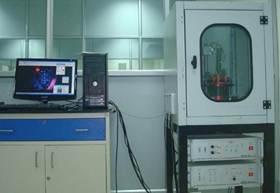
C. Scanning Electron Microscopic Studies (SEM): TiN coated AA2024 and the powders were studied under scanning electron microscope mostly using secondary electron imaging. The surface, as well as theinterfacemorphologyofallcoatings,wasobserved under the microscope. The detailed procedure for preparingthespecimenfortheSEMstudiesisshown in Fig.8.
Fig. 5 Sputtering Processing Machine
Fig. 8 Procedure for preparing the specimen for SEM
VI. Results and Conclusion
A. SEM Analysis:
Fig. 9 shows the surface of the TiN coating in the Aluminium Alloy 2024. The surface finish of the coating is smooth and the thickness we get is 1.465 µm.Themagnitudewillbe1.00KXandEHTwillbe 10.00KVandWDwillbe10.4mm,andthesignalA = SE2. The coating is viewed in the microscopic at 20µm. After the SEM analysis, using the Electron is diffractedonthetargetmaterialtoviewthesurfaceof thecoatingasshownin Fig.10.
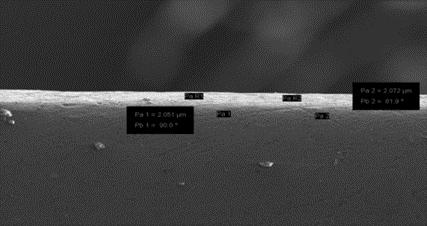
calledastestloadorappliedforce,whichcanbeat11000gf, on the material under testing. And the diameter of the indentations test involves 50mm and 60mm,whichareroughlyequivalentto2gf.Thisforce can produce an indentation of around 50µm. Fig.12 shows that the different loading conditions at 1µm, 1.46µm,2µm,2.2µm.Becauseofitsspecificity,this type of testing is applicable in cases where there is needtowatchforhardnesschangesonamicroscopic level.
Fig.9. The cross-section and the surface of the TiN coating, SEM

Fig.12 Hardness Test after coating


C. XRD Analysis:
From this Fig.14, we obtained that the Titanium nitride was finely coated over the substrate Aluminiumandthecharacteristicsofthesubstratefor various thicknesses was studied, examined and analyzed over the period of time and results were obtained.

Fig.11.Electron diffraction on the target material
This surface of the TiN coating material is shown in Fig.11usingthemicroscopicview.Thiswillhelpthe TiN is packed with the AA2024 without the air bubblesinbetweenthemoleculesofTiN.
B. Hardness Test:
In thistestingmethod, theuseofadiamond indenter withaparticularshapeisusedtomakeanimpression
Fig.14. XRD Analysis
We conclude this study as a substrate was designed for the sputtering process in which Titanium Nitride was coated over Aluminium 2024 alloy by physical vapourdepositionofgas.Theresultingprototypewas then tested to get the appropriate results in different loadingconditionsvarioustypesoftestsweretakento get the best result of the substrate for which it was developed. From that, we conclude that Titanium Nitride coated Aluminium 2024 alloy possesses excellent result compared to normal Aluminium alloy.
References
[1] American Society for Testing and Materials. Standard test method for measurements of fatigue crack growth rates. Annual Book of
International Journal of Trend in Scientific Research and Development @ www.ijtsrd.com eISSN: 2456-6470
ASTMStandards2000:Volume03.01,ASTM E 647. p. 591–630.
[2] Joyia, Muhammad Ghufran, “Comparative performanceanalysisofcementedcarbide,TiN, TiAlN, and PCD coated inserts in dry machiningofAl2024alloy”,TheInternational Journal of Advanced Manufacturing Technology volume 112, pages1461–1481 (2021).
[3] S. Balanand, S. Bhowmik, M. Datta, R. Rane, and S. Mukherjee, "Surface Characteristics of Plasma Treated and Titanium Nitride (TiN) Deposited Aluminum Alloy", Materials Performance and Characterization 8, no. 1 (2019): 468-480.
[4] C.Lu,J.W.Yao,Y.X.Wang,Y.D.Zhu,J.H.Guo, Y.Wang, H.Y.Fu, Z.B.Chen, M.F.Yanb, “A novelanti-frictionalmultiphaselayerproduced by plasma nitriding of PVD titanium coated ZL205A aluminium alloy”, Applied Surface Science,Volume431,15February2018,Pages 32-38.
[5] FanyongZhang, MufuYan, JiningHe, FuxingYin,“Microstructureevolutionandwear resistance of nitride/aluminide coatings on the surface of Ti-coated 2024 Al alloy during plasma nitriding, Ceramics International”, Volume 43, Issue 14, 1 October 2017, Pages 10832-10839.
[6] FanyongZhang, YiDing, ShuYan, JiningHe, FuxingYin, “Microstructure evolution and mechanical performance of Cr-N/Al-Cr multilayer coatings produced by plasma
nitridingCr-coatedAlalloy”,Vacuum,Volume 180, October2020, pp.109540-109544.
[7] R.N.Ibrahim, M.A.Rahmat, R.H.Oskouei, R.K.Singh Raman, “Monolayer TiAlN and multilayerTiAlN/CrNPVDcoatingsassurface modifiers to mitigate fretting fatigue of AISI P20 steel”, Engineering Fracture Mechanics, Volume137, March 2015, Pages 64-78.
[8] Soroush Momeni, WolfgangTillmann, “Investigation of the self-healing sliding wear characteristicsofNiTi-basedPVDcoatingson tool steel”, Wear, Volumes 368–369, 15 December2016, Pages 53-59.
[9] Ali Shanaghi, Ali Reza Souri, Mahdi Rafie & Paul K. Chu, “Effects of Benzotriazole on nano-mechanical properties of zirconia–alumina–Benzotriazolenanocompositecoating deposited on Al 2024 by the sol–gel method”, Applied Physics A volume 125, Article number: 728 (2019).
[10] Bing Li, Fei Sun, QizhouCai,Jingfan Cheng, Bingyi Zhao, “Effect of TiN nanoparticles on microstructure and properties of Al2024-TiN nanocomposite by high energy milling and sparkplasmasintering”, JournalofAlloys and Compounds, Volume 726, 5 December 2017, Pages 638-650.
[11] Sun, Fei Li, Bing, Cai, Chao, Cai, Qizhou, “Effects of TiN nanoparticles on hot deformation behavior of ultra-fine grained Al2024-TiNnanocompositespreparedbyspark plasma sintering, Mechanics of Materials, Volume138, November 2019, pp.103152.
